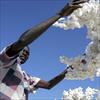
Senegal
SENEGAL: The “missing middle” – tackling youth unemployment
WEST AFRICA: Meningitis emergency vaccine stock tapped early
Synchronized polio campaign kicks off across eight countries in West Africa
SENEGAL: Squeezing more out of sesame
WEST AFRICA: Can organic cotton save the industry?
SENEGAL: Coastal erosion research goes unfunded
National name: République du Sénegal
Geography
Capital: Dakar
Major Towns: Dakar, St.Louis, Thies, Tambakunda, Kaolak, Ziguinchor,
Location (geographical coordinates/latitude and longitude): Dakar: 14°40'N, 17°25'W
Time Zone: UTC
Size (Land and Sea:) 196,723 km², Water: 2.1%
Borders with the Atlantic Ocean, Mauritania, Mali, Guinea and Guinea-Bissau. Gambia lies almost entirely within Senegal, surrounded on the north, east and south; from its western coast, Gambia's territory follows the Gambia River more than 300 kilometers (186 mi) inland.
Elevation extremes: Lowest point: Atlantic Ocean 0 m, highest point: unnamed location in the Futa Jaldon Hills: 581m
Politics
Head of State: President: Abdoulaye Wade, Prime Minister: Cheikh Hadjibou Soumaré
Form of Government: Semi-presidential Republic
Independancy (from France): June 20, 1960
Currency: CFA Franc
Industry
Main industries (income) food processing, mining, cement, artificial fertilizer, chemicals, textiles, refining imported petroleum, and tourism. Exports include fish, chemicals, groundnuts, and calcium phosphate
Other Industries: Agricultural and fish processing, phosphate mining, fertilizer production, petroleum refining, construction materials, ship construction and repair.
Natural resources: fish, phosphates, iron ore
Agriculture: peanuts, millet, corn, sorghum, rice, cotton, tomatoes, green vegetables; cattle, poultry, pigs; fish
Population and People
Population: 12,521,851 (2007 est.); 11,658,000 (2005 est.)
Population density per sq mi: 169
Growth rate: 2.6% (2007 est.)
Birth rate: 37.4 births/1,000 population (2007 est.)
Total fertility rate: 5 children born/woman (2007 est.)
Infant mortality rate: 60.2/1000
Religion: Islam: 95%, Christianity: 4%, Animism: 1%
Languages: French, Wolof, Mandinka, Jola, Fula
Ethnic groups / Tribes: Wolof: 43%, Peuls and Toucouleur (also known as Halpulaar, Fulbe or Fula) (24%),others: Serer (15%), Lebou (10%), Jola (4%), Mandinka (3%), Maures or Naarkajors, Soninke, Bassari and many smaller communities (9%). About 50,000 Europeans (1%) (mostly French) as well as smaller numbers of Mauritanians and Lebanese reside in Senegal
Age structure: 0-14 years: 42% (male 2,656,122/female 2,608,423); 15-64 years: 55% (male 3,426,504/female 3,454,372); 65 years and over: 3% (male 176,877/female 199,553) (2007 est.)
Life expectancy: 56.7
Literacy: Total population: 39.1%, male: 51.1%, female: 28.9% (2001 est)
coming...
 Text Area - Senegal
Text Area - Senegal Content List - Senegal News
Content List - Senegal News





 Map - Senegal Map
Map - Senegal Map